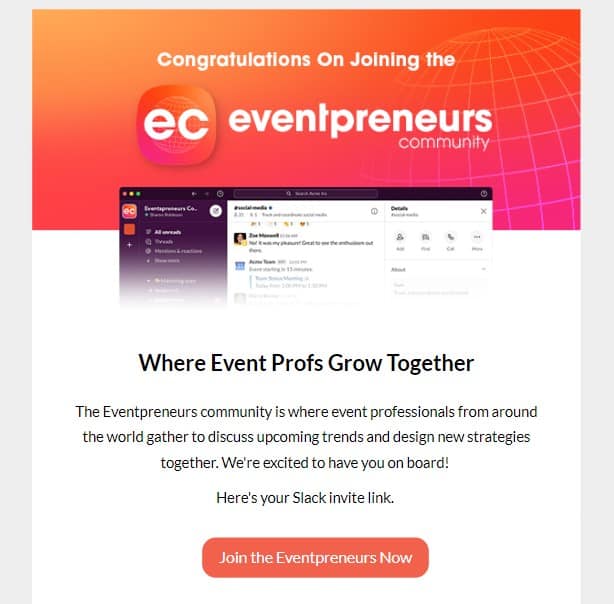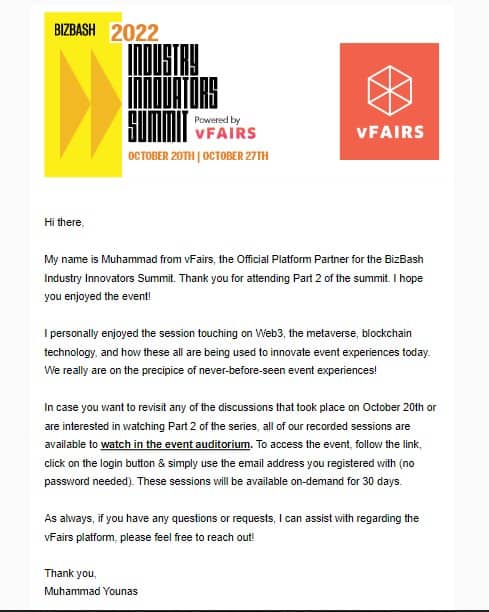Whether you’re hosting your first virtual, hybrid, or in-person event or a seasoned expert with several successful events, communication with exhibitors and attendees is critical to show your stakeholders the bigger picture you’re trying to paint. A communication plan for an event is a detailed list of what to say to your audience, when to say it, and how to reach them to ensure your event goes well. A good event communication plan has three main benefits:
- It gets people excited about your event.
- Gets people involved before, during, and after the event
- Keep everyone on your team on the same page to avoid potential problems.
Tips for Successful Event Email Marketing
Despite being used in event marketing for years, email is still a powerful tool. Email marketing for events is highly effective. It still accounts for a sizable amount of most marketers’ efforts, even though they are increasingly turning to social media to reach their target audience.
Here are a few event email templates and tips to help maximize click and click-through rates!
1. Use Clear Subject Lines
You should expect your email to be opened or deleted based on the quality of your subject line. To reassure the reader that you are not a computer program, keep your subject lines brief, pleasant, and personal. Here are 30 Compelling Email Subject Lines for Effective Event Marketing that can help you create the best subject lines for your recipients. Look how the subject line for this downloadable guide mail is clear and concise!
![]()
2. Build Suspense
With the first email, you want to get the conversation and get people interested. If it’s the first event of its kind, use phrases like “Coming Soon” or “First-Ever” to get people interested.
If something happens annually, saying “We’re Back” or “Get Ready” can be a fun way to let people know about it. Maintain an air of mystery around the facts while developing suspense, but not so much that it’s overly unclear or confusing.
3. Segment Your Audience
By dividing your audience into groups, you can ensure that your email marketing gets to the right people and that you don’t bore them with the information they don’t need. For instance, if you’re running an event with many exhibitors, your list might consist of 80% of people who just want to attend and 20% of people who have shown interest in exhibiting. If you send an email about exhibiting to the 80% of attendees, you’ll show them that your emails are only sometimes worth opening at worst. This can make low open rates more likely.
Below is an email template for the Slack invite link segmented for the ones who registered for the Slack community. This email got a 65.31% click rate and an 87.7% click-through rate!

4. Make it Interesting
Send out an email before your event with some fun facts and FAQs, as well as some interesting facts about the speakers or vendors, along with headshots and other relevant photos.
You can also share numbers from past events to give your guests an idea of what to expect and get them excited about what’s to come. Attractive color schemes, bold fonts, and graphics can also help to break up the text.
5. Create a Dialogue
The most effective approach is to introduce yourself in one line (sharing your occupation and the reason for your contact) and then ask a straightforward question. For example, instead of asking whether they need someone to organize their events in general, ask if they need an experienced event planner to develop a strategy for next year’s annual summit. This way, you can share your interest rather than just hustling up new business wherever you can.
6. Keep the CTA Simple
Simply state your goal for your audience. There is a place for creativity, but it often comes down to clear and concise action. You want your message to be clear about what you want and what you need from people.
Do you want to invite someone? Telling them to keep the date in mind? Have some big news to share? Put this action in the subject line and link it to bold, clickable buttons in the body of the email. Try to put yourself in your readers’ shoes; they probably get dozens, if not hundreds, of emails daily. As they look through their email, your message needs to stand out.
This Interprefy webcast reminder email had a 31.78% click rate and 46.6% click-through rate. Look at the event email template below and see how the CTA is clear and concise with all details mentioned!

7. Accurately Place Buttons
Event email marketing often aims to get readers to visit a specific landing page. Make it clear by putting strong and well-thought-out CTA buttons like:
- “Register”
- “Sign up”
The buttons should be big and stand out with a color that doesn’t clash with the rest of the design. Make sure there is enough breathing room around the buttons to make it clear that they are the focal points of the page. Below is an event email template showing an excellent example of placing buttons precisely. Look how the RSVP button stands out in this meet-and-greet invitation mail that got an 11.11% click rate and 33.3% click-through rate.

8. Keep the Text Mobile-friendly
How often do you find that a promotional email’s text cuts off on your smartphone, leaving you to miss half the message? If your message doesn’t make sense, people won’t care what you’re trying to say.
If it’s made for the web or mobile, your content will appear suitable, and you could gain clicks and people at your next big event. Make your message clear and to the point so you will retain the text.
9. Target Email Reminders to Appropriate Readers
You must keep reminding people about your event, but you should never be irritating. You should avoid annoying your email recipients to the point that they unsubscribe. Instead, keep emails fresh, inviting, and engaging by continually providing new information, crucial reminders, and high-quality content.
The primary consideration is sending reminders to the right person: Who has already signed up and needs information about the event? Who still needs to sign up but reads every email? Who has yet to open a single email, and this is your last request? For the best results, tailor your reminders to different groups of people.
10. Follow Up
Send emails after the event to thank people for coming. Make them feel like their time is valuable. Show your interest in their feedback to incorporate it into future events. This follow-up could also include highlights from the event, like video clips and photos that people will remember, exciting facts, and a poll or survey to get feedback.
You can also add links to content that has already been recorded and encourage people to share your content on social media to reach more people and get more attention. For example, here’s a BizBash post-event email template with a 13.33% click rate and a 25% click-through rate!

Key Takeaway
Email marketing is crucial for an event’s success. Although, no email could ever be flawless. Still, email marketing can work if you write each email with a goal in mind, like getting people to sign up for an event or download a new piece of content. We hope these event email templates help you understand how to create successful email marketing.

